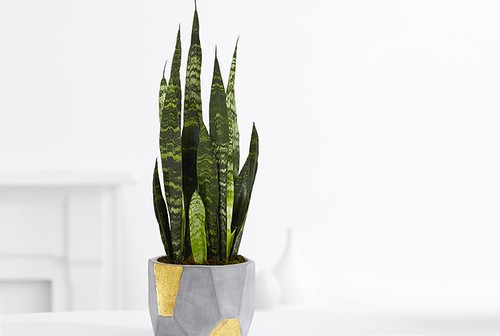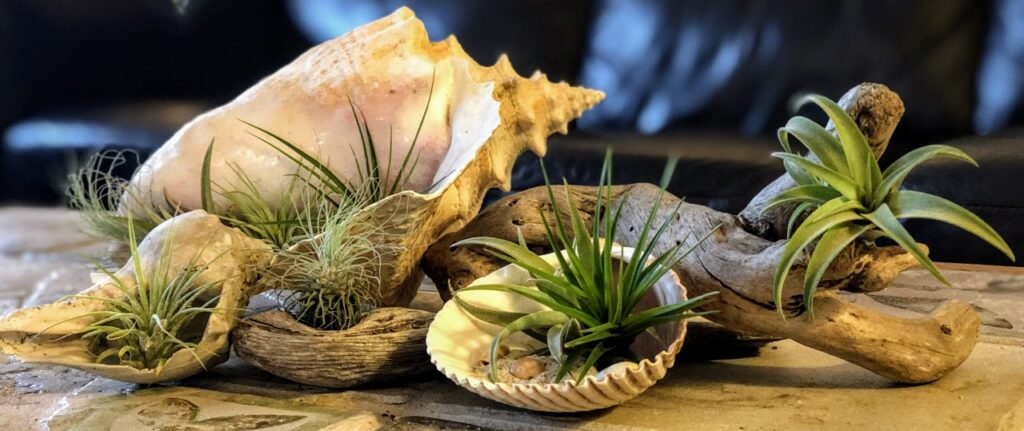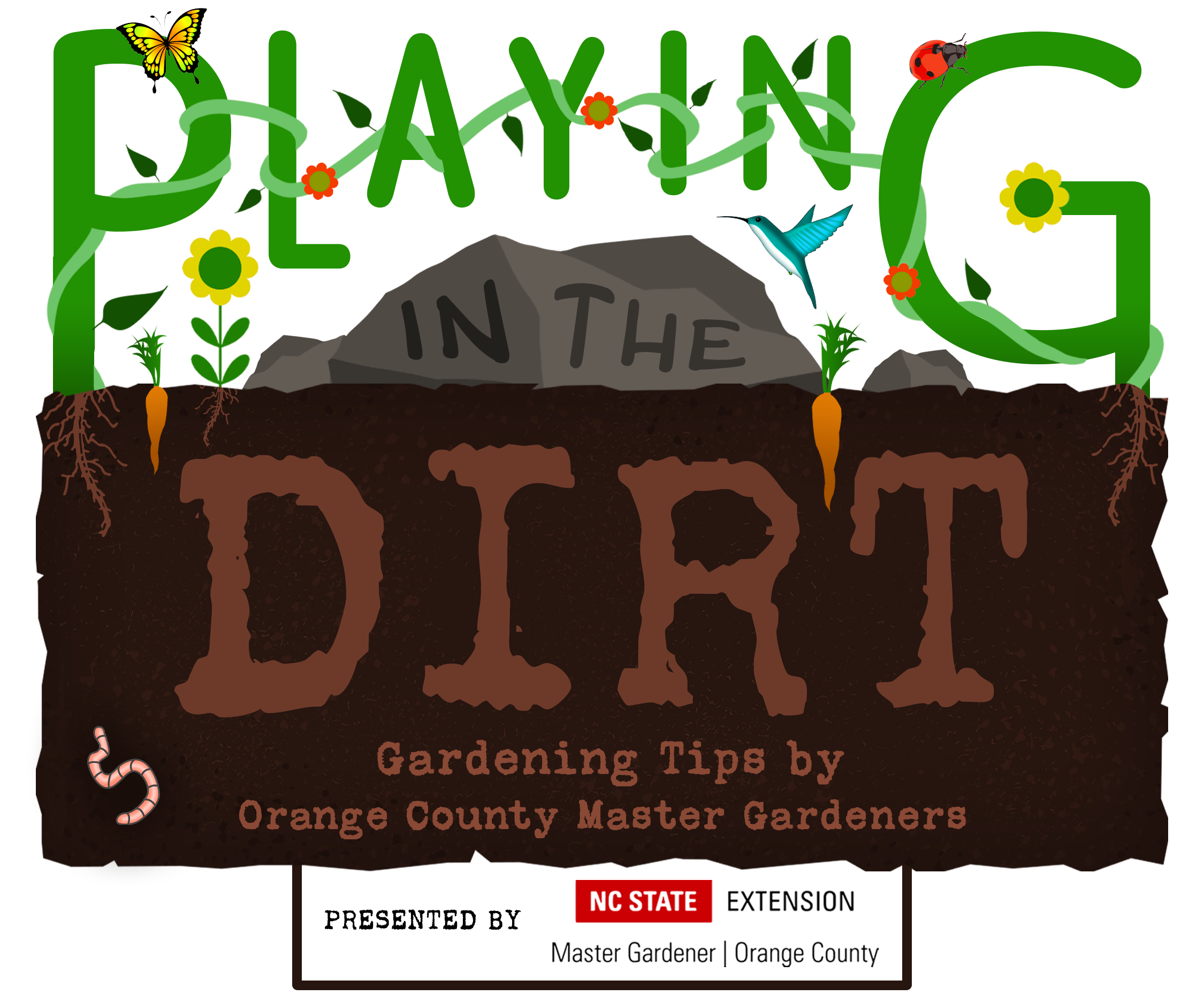
97.9 The Hill and Chapelboro.com have partnered with Orange County Master Gardeners for “Playing in the Dirt,” a monthly column exploring the fertile ground of home gardening in our community and intended to provide the information and inspiration gardeners of all skills levels need to flourish! Check back on Chapelboro each month for a new subject – from our gardens to yours!
By Lynn Calder, Orange County Master Gardener Volunteer
Plants are beneficial for our indoor spaces! They add beauty to our surroundings, and research has shown that indoor plants contribute to our health and well-being. Plants take in carbon dioxide, emit oxygen, humidify the air and improve air quality by reducing pollutants. Indoor plants also can boost positive emotions, reduce stress, improve concentration and productivity and help relieve physical discomfort. Some give off a pleasant aroma from essential oils and can even help us sleep better.
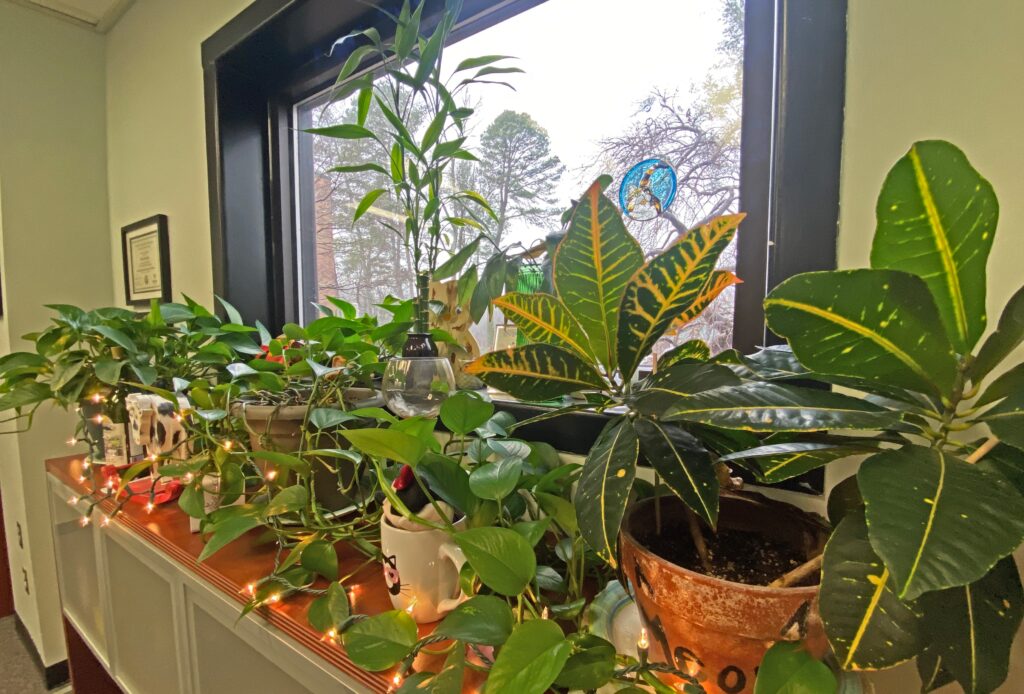
Improve your air quality with houseplants! (Photo by Sarah Christas, NC Cooperative Extension, Caldwell County)
Getting Started – Consider Your Available Light
Most indoor plants are easy to grow and care for. However, before heading out to a garden center, consider two important factors: the time you have to maintain the plants and the available light in your home. Plants must have proper light to thrive — you should choose a particular plant based on the light it will receive in your room. Take a look around, think about where you want to place a plant and notice the light that reaches that area.
The amount of light a plant receives in an indoor area, known as light intensity, is categorized as high, medium or low. The plant label, resources listed at the end of this article and knowledgeable garden center staff can provide specific information on light needs. Except for cacti and succulents, most species of indoor plants are native to tropical rainforests, growing in filtered sunlight (medium light) and year-round warmth (65 degrees to 80 degrees). In our area, the brightest light will typically come from windows that face south, east or west.
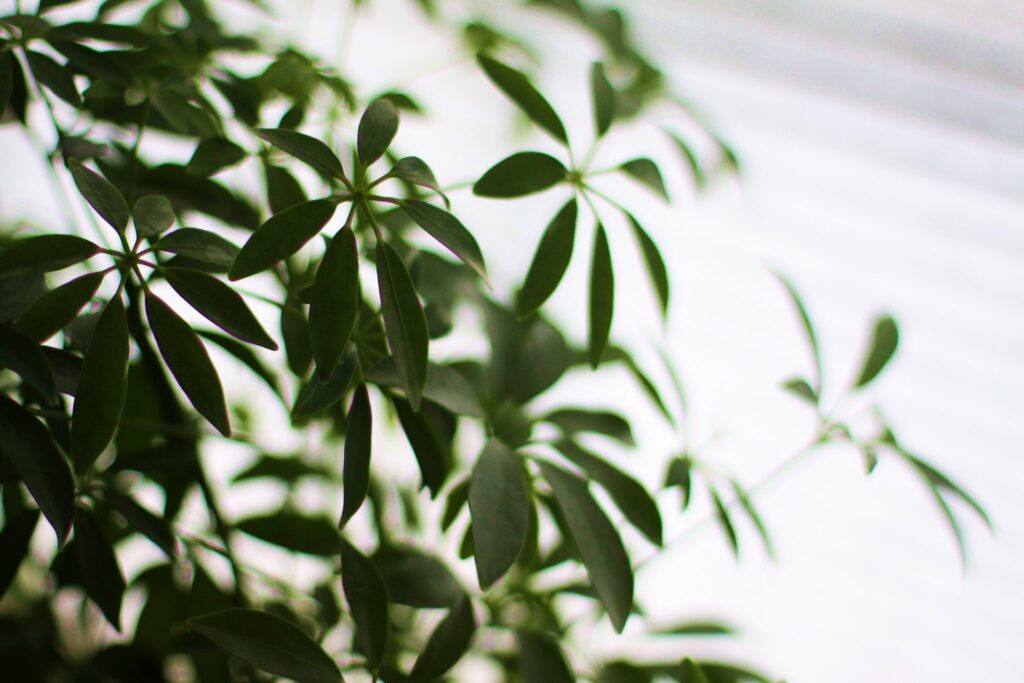
The Dwarf Umbrella Tree, also called Dwarf Schefflera, prefers medium light. (Photo by Dave Hosford, “Simple Houseplant,” CC BY 2.0)
When evaluating light from your windows, take into account any shade created by window treatments, roof overhangs, and nearby buildings, shrubbery or trees. Light intensity is influenced by the time of year as well — the angle and direction of incoming sun changes with the seasons in North Carolina.
Here is general guidance for determining light intensity indoors:
- “Low light” areas are more than 8 feet away from a window, in dimly lit corners, centers of rooms, hallways, rooms with only north-facing windows and rooms that receive only artificial light.
- “Medium light” areas are 4 to 8 feet away from south or west windows and areas within 4 feet of west windows that don’t receive direct sun.
- “High light” areas are within 4 feet of large windows that face south, east or west onto mostly open sky.
It’s helpful to routinely turn plants so that each side benefits from sun exposure. And you can help plants in low light by occasionally moving them to a brighter area for four to eight weeks.
While natural light is ideal because it provides all the colors of the spectrum plants need, fluorescent lights or LED grow lights used 12 to 14 hours a day will improve growth, especially in low light areas. Horticultural LED lights that emit only the wavelengths used most by plants are available and are long-lasting and economical. Plants should be placed 1 to 3 feet below artificial light, depending on the light requirements of the plant (low, medium or high) and the brightness of the light.
Caring for Your Indoor Plants
Repotting:
If you want to repot your new indoor plant, choose a container 1 to 2 inches larger in diameter than the existing pot and be sure it is thoroughly clean. The container must have drainage holes! Plants grown in containers, indoors or outdoors, have special soil needs and garden centers sell various soil mixes depending on the plant’s moisture and nutrient needs. Most mixes don’t contain soil but are instead a sterile combination of organic and inorganic matter; soil dug up outside is not suitable for growing plants in pots. You also can make your own potting mix: this article has recipes for mixing potting soil for different types of indoor plants and advice on plant growth and care.
Moisten the mix to slightly wet before inserting the plant (which also should be moist). Fill the pot with soil mix so that the top of the root mass is within 1 inch of the top of the container; then fill around the plant. Be careful not to damage the delicate roots. Water thoroughly after potting and allow the newly potted plant to recover by placing it in indirect light for seven to 10 days.
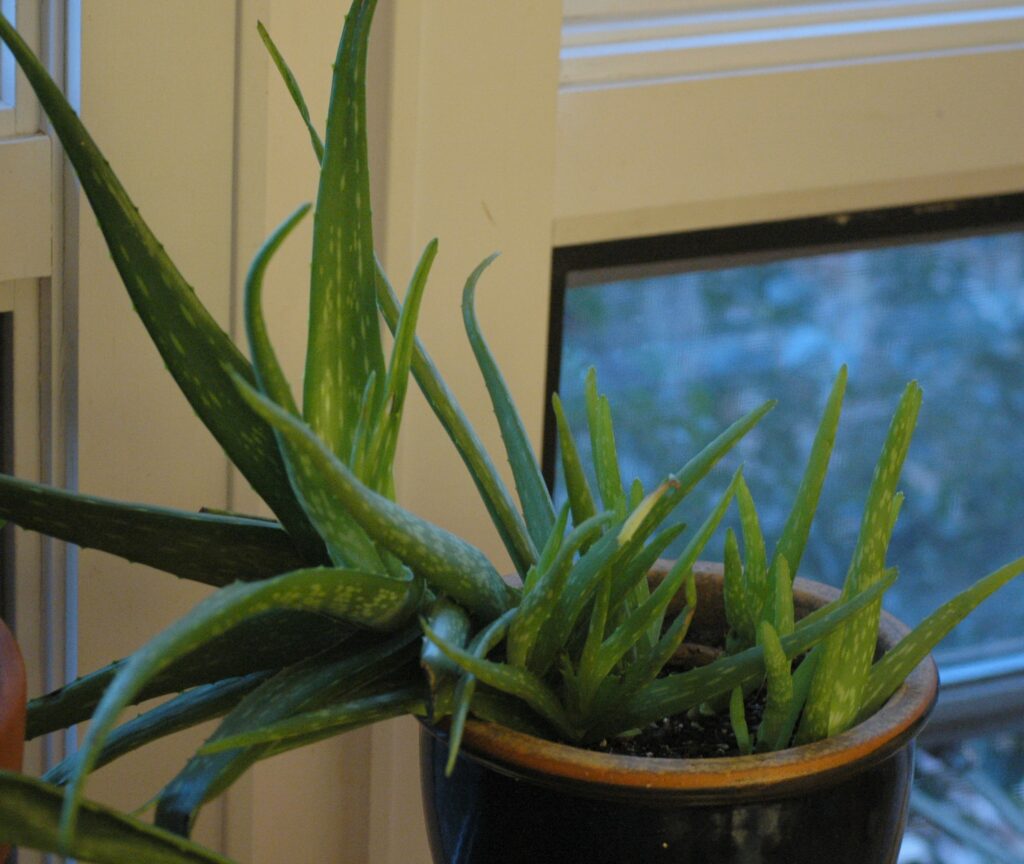
Aloe Vera that may be outgrowing its pot; the offshoots could be transplanted into a new pot. (Photo by Lynn Calder)
Water, Humidity and Temperature:
Improper watering is a second major reason most indoor plants do not thrive; being too dry or too wet will damage roots and injure a plant to the point of death. How do you know when a plant needs watering? Check the soil! Soil that is drying out becomes lighter in color and dry to the touch, the pot weighs less and eventually, the soil will pull away from the sides of the pot. If you stick your finger an inch or 2 into the potting mix and it feels dry, it’s probably time to water. While you don’t want to allow the plant to wilt, indoor plants usually need less water than you think, especially in winter; and more are killed by over-watering than under-watering. If you find that the soil consistently dries out within just a few days, the roots may have filled up the pot, and it’s time to re-pot the plant into a larger container.
It’s essential to have your plant in a pot with drainage holes. When watering the plant, wet the entire soil — not just the top — until the water drains from the bottom. If your potted plant sits in a saucer or a decorative container with no drainage, be sure to pour off the excess water. Never leave a plant sitting in water.
Most indoor plants, other than cacti and succulents, love humid air. Our homes and offices often are dry, especially in winter. You can add moisture to the air around your plants in several ways: by placing the potted plant on top of a tray filled with moist sand or gravel (without allowing the pot to sit in the wet sand or gravel), using a humidifier in the room or by placing a bowl of water on top of a wood stove or near the plants to evaporate. Grouping plants together so there is a canopy of leaves even helps them trap moisture.
If you place plants close to windows, notice the effects of the sun and season. Most indoor plants thrive in temperatures from 65 to 75 degrees during the day and 10 degrees cooler at night. The area next to windows may become too warm in bright summer sun. The winter season offers its own set of challenges for plants. Sudden change in environmental conditions can harm any indoor plant, and tropical foliage plants can be injured if exposed to temperatures below 40 degrees. Be sure plants aren’t next to cold windows or placed in the cold spot between closed drapes and the window. Watch out for drafts, especially if plants are placed near doors. Hot air from radiators, heat registers, wood stoves and fireplaces may cause your plants to dry out quicker and may injure plants placed too close to these heat sources.
Feeding, Cleaning and Treating for Pests:
Specially formulated fertilizers are available for houseplants in controlled, slow and fast-release forms. All three have synthetic formulations and slow-release fertilizers include an organic option. The different types can be used independently or in combination — follow label directions closely for the function you need. Apply fertilizers after watering and be careful not to over-fertilize.
Indoor plants will decrease or stop growing during the shorter days and less intense light of winter; they do not need fertilized in winter when they’re not growing. When indoor plants are producing new growth or are flowering, fertilizing once a month or less usually is enough.
Too much dust on plant leaves can hinder the plant’s ability to photosynthesize (create food) for itself. You can gently wash top surfaces of leaves with a soft cloth moistened with warm water every few months. You also can shower plants outside with the hose (if not too cold!) or in your tub. Be sure to let them drain well and dry before being exposed to cooler night temperatures. Avoid using leaf shine products: they attract more dust and clog microscopic leaf pores.
Indoor plants will occasionally be bothered by pests, usually aphids, spider mites, mealy bugs or scales. Signs of a pest problem include sticky leaves, white cottony masses, brown bumps on stems and gray fuzzy growth on leaves. These can be treated with insecticidal soap or a systemic pesticide found at a garden store and following label directions. Take care to isolate an infected plant until the problem is resolved so that your other plants aren’t affected.
While managing pests on your indoor plants, it’s crucial to consider the broader implications for the well-being of your home environment. If pest issues persist or if you prefer a professional touch, it’s wise to enlist the services of experts in pest control. Companies like Safe Pest Control specialize in providing effective and safe pest control solutions. You can see safepestcontrol.net.au for more information. Their expertise ensures not only the elimination of pests but also the prevention of future infestations, promoting a healthier and more vibrant indoor environment. By incorporating professional pest control services, you go beyond addressing immediate concerns, creating a long-lasting and pest-free sanctuary for your beloved indoor plants and the overall well-being of your home.
Some Indoor Plant Choices
Once you consider the light in your home or office and how much time you want to spend caring for your plant, check out the selection available at a reputable garden center. Be sure to read the plant label to see which ones fit your needs.
To get you started, here are ideas for some popular indoor plants. You can easily use the search tool on the North Carolina Extension Gardener Plant Toolbox website to find photos, best growing conditions and poison characteristics for these plants.
For high light: Cacti, succulents such as Jade Plant (Crassula arborescens) and Aloe Vera (Aloe vera), Norfolk Island Pine (Araucaria heyterophylla), African Violet (Saintpaulia ionantha).
For medium or filtered light: Boston Fern (Nephrolepis exaltata), Weeping Fig (Ficus benjamina), Spider Plant (Chlorophytum comosum), Rubber Plant (Ficus elastica), Peace Lily (Spathiphyllum), Dwarf Umbrella Tree or Dwarf Schefflera (Heptapleurum arboricola). Several plants that share the common name Philodendron — Monstera deliciosa (not actually a philodendron but a woody epiphytic vine), Philodendron selloum and Thaumatophyllum bipinnatifidum — have large showy leaves, grow well indoors in medium light and may tolerate low light for a period of time.
Tolerate low light: Chinese Evergreen (Aglaonema modestum), Cast Iron Plant (Aspidistra elatior), Moon Orchid (Phalaenopsis), Snake Plant (Dracaena trifasciata), Bamboo Palm (Chamaedorea seifrizii).
And, if you’d like a little green in your indoor space with the least amount of maintenance, try an air plant (Tillandsia)! Air plants are epiphytes — they have no roots or only roots used to anchor themselves to objects — and they come in a variety of shapes and sizes. For most, you only need to mist them a few times a week and soak them in tepid water for about 15 minutes every few weeks (more often in winter if the air is very dry). After soaking, they need to drain well upside down. Air plants prefer bright, filtered light and can be displayed creatively in a terrarium, a shallow dish, or placed in seashells or hanging glass holders. This article explains more about growing these unique plants.
For more information about growing and caring for indoor plants:
North Carolina Extension Gardener Handbook:
Video: Selecting the Right Houseplant (N.C. State Extension)
Care and Selection of Indoor Plants (Mississippi State Extension)
Colorado State University Extension “Plant Talk Colorado” | Houseplants (includes links to many houseplants with photos, descriptions and care advice)
Check us out!
Have a plant or garden question for the Orange County Master Gardener volunteers? Email ocmgardeners@gmail.com or phone 919-245-2061.
The Orange County Master Gardener volunteers hope you’ll subscribe to The Garden Buzz, our new monthly newsletter that highlights local gardening news, events and tips. You can subscribe here. And please visit our website, The Orange Gardener.
Chapelboro.com does not charge subscription fees, and you can directly support our efforts in local journalism here. Want more of what you see on Chapelboro? Let us bring free local news and community information to you by signing up for our biweekly newsletter.



